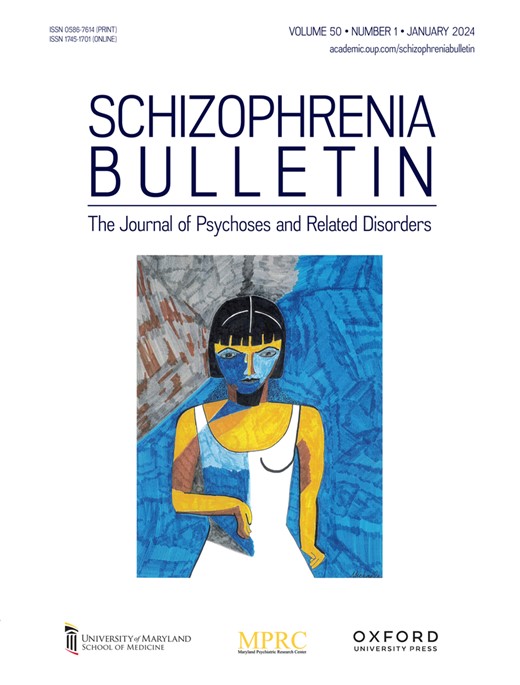64 ANALYSIS OF THE EFFECT OF DIGITAL MEDIA ART INTERVENTION ON THE RECOVERY OF SOCIAL FUNCTION IN PATIENTS WITH CHRONIC SCHIZOPHRENIA
IF 4.8
1区 医学
Q1 PSYCHIATRY
引用次数: 0
Abstract
Background Schizophrenia significantly impairs patients’ social functioning, including social interaction, work ability, and daily living skills. Among these, the damage to social functioning is a crucial barrier in the recovery process of patients with schizophrenia. In recent years, Digital Media Art (DMA) has been introduced as an innovative therapeutic approach for patients with schizophrenia. Therefore, this study aims to clarify the impact of DMA on the social functioning of patients with chronic schizophrenia. Methods The study included 100 patients, aged 25 to 60, diagnosed with chronic schizophrenia, with a duration of illness exceeding five years. Patients were randomly divided into Group A (n=50) and Group B (n=50). Group A received standard treatment, while Group B received standard treatment plus a 12-week DMA intervention. The intervention included creative activities using digital tools twice a week. The Scale for the Assessment of Social Functioning (SASF) was used to assess patients’ social functioning, and the MATRICS Consensus Cognitive Battery (MCCB) was used to evaluate cognitive functioning. Data were analyzed using mixed-design ANOVA to compare changes in social and cognitive functioning over time between the two groups. Results The SASF score of group A increased from 57.9 to 63.5 before the intervention. The SASF score of group B increased from 58.2 to 82.4 before the intervention. Group B showed a significant improvement in social functioning (F (1,98) =23.45, P<0.001) and cognitive functioning (F (1,98) =15.67, P<0.001) compared to group A. The SASF score of group B increased from 58.2 to 82.4 before the intervention. Before the intervention, the MCCB score was 65.4 in group A and 64.8 in group B. The difference was not significant (P>0.05). After the intervention, group A scored 69.2 on the MCCB and group B scored 76.3, with a significant difference (P<0.05). The effect sizes of the intervention were more pronounced for social functioning in group B (Cohen’s d=0.89) and more moderate for cognitive functioning (Cohen’s d=0.58). On attention/vigilance (MCCB subscale), the average score for Group A improved only from 8.0 to 8.8, while the average score for Group B improved from 8.1 to 9.5. Subgroup analyses showed that younger patients (<40 years) benefited more from the DMA intervention in terms of social perception and facial emotion recognition. 76% of patients in group A were satisfied with the treatment, and 97% of patients in group B were satisfied with the DMA intervention. Discussion The findings suggest that DMA intervention can significantly enhance the social and cognitive functioning of patients with chronic schizophrenia. The creative and participatory nature of the intervention may provide a motivational boost, leading to better social engagement and cognitive stimulation. The differential effects based on age highlight the importance of tailored interventions. The study’s limitations include the lack of long-term follow-up and the potential influence of patient variables such as medication adherence. Future research will explore the long-term efficacy of DMA interventions and integrate biological markers to better understand the underlying mechanisms.数字媒体艺术干预对慢性精神分裂症患者社会功能恢复的影响分析
精神分裂症显著损害患者的社会功能,包括社会交往、工作能力和日常生活技能。其中,社会功能的损害是精神分裂症患者康复过程中的一个重要障碍。近年来,数字媒体艺术(DMA)作为精神分裂症患者的一种创新治疗方法被引入。因此,本研究旨在阐明DMA对慢性精神分裂症患者社会功能的影响。方法纳入100例慢性精神分裂症患者,年龄25 ~ 60岁,病程超过5年。患者随机分为A组(n=50)和B组(n=50)。A组采用标准治疗,B组采用标准治疗加12周DMA干预。干预包括每周两次使用数字工具进行创造性活动。社会功能评估量表(SASF)用于评估患者的社会功能,认知功能评估量表(MCCB)用于评估患者的认知功能。使用混合设计方差分析分析数据,比较两组之间随时间的社会和认知功能的变化。结果A组SASF评分由干预前的57.9分提高到干预前的63.5分。B组SASF评分由干预前的58.2分提高至干预前的82.4分。与a组相比,B组在社会功能(F (1,98) =23.45, P<0.001)和认知功能(F (1,98) =15.67, P<0.001)方面均有显著改善,干预前B组SASF得分由58.2上升至82.4。干预前A组MCCB评分为65.4分,b组为64.8分,差异无统计学意义(P>0.05)。干预后A组MCCB得分为69.2分,B组为76.3分,差异有统计学意义(P<0.05)。干预对B组社会功能的影响更明显(Cohen’s d=0.89),对认知功能的影响更温和(Cohen’s d=0.58)。在注意/警惕性(MCCB子量表)上,A组的平均得分仅从8.0提高到8.8,而B组的平均得分从8.1提高到9.5。亚组分析显示,年轻患者(40岁)在社会知觉和面部情绪识别方面从DMA干预中获益更多。A组76%的患者对治疗满意,B组97%的患者对DMA干预满意。研究结果表明,DMA干预可以显著提高慢性精神分裂症患者的社会和认知功能。干预的创造性和参与性可能会提供一种激励,从而导致更好的社会参与和认知刺激。基于年龄的不同效果突出了量身定制干预措施的重要性。该研究的局限性包括缺乏长期随访和患者变量(如药物依从性)的潜在影响。未来的研究将探索DMA干预的长期疗效,并整合生物标志物,以更好地了解其潜在机制。
本文章由计算机程序翻译,如有差异,请以英文原文为准。
求助全文
约1分钟内获得全文
求助全文
来源期刊

Schizophrenia Bulletin
医学-精神病学
CiteScore
11.40
自引率
6.10%
发文量
163
审稿时长
4-8 weeks
期刊介绍:
Schizophrenia Bulletin seeks to review recent developments and empirically based hypotheses regarding the etiology and treatment of schizophrenia. We view the field as broad and deep, and will publish new knowledge ranging from the molecular basis to social and cultural factors. We will give new emphasis to translational reports which simultaneously highlight basic neurobiological mechanisms and clinical manifestations. Some of the Bulletin content is invited as special features or manuscripts organized as a theme by special guest editors. Most pages of the Bulletin are devoted to unsolicited manuscripts of high quality that report original data or where we can provide a special venue for a major study or workshop report. Supplement issues are sometimes provided for manuscripts reporting from a recent conference.
 求助内容:
求助内容: 应助结果提醒方式:
应助结果提醒方式:


